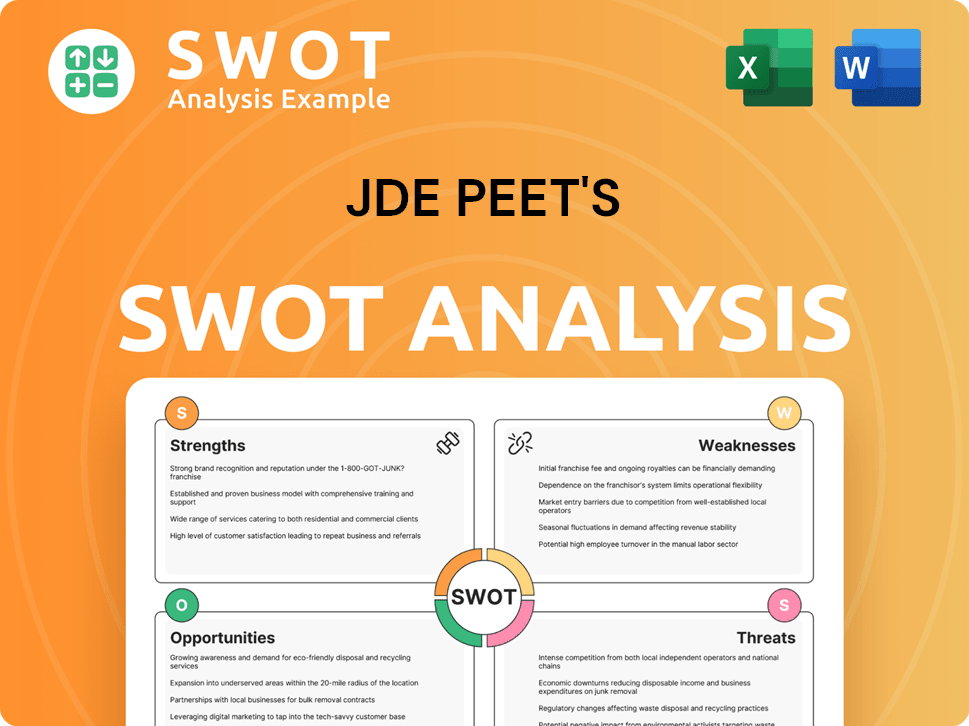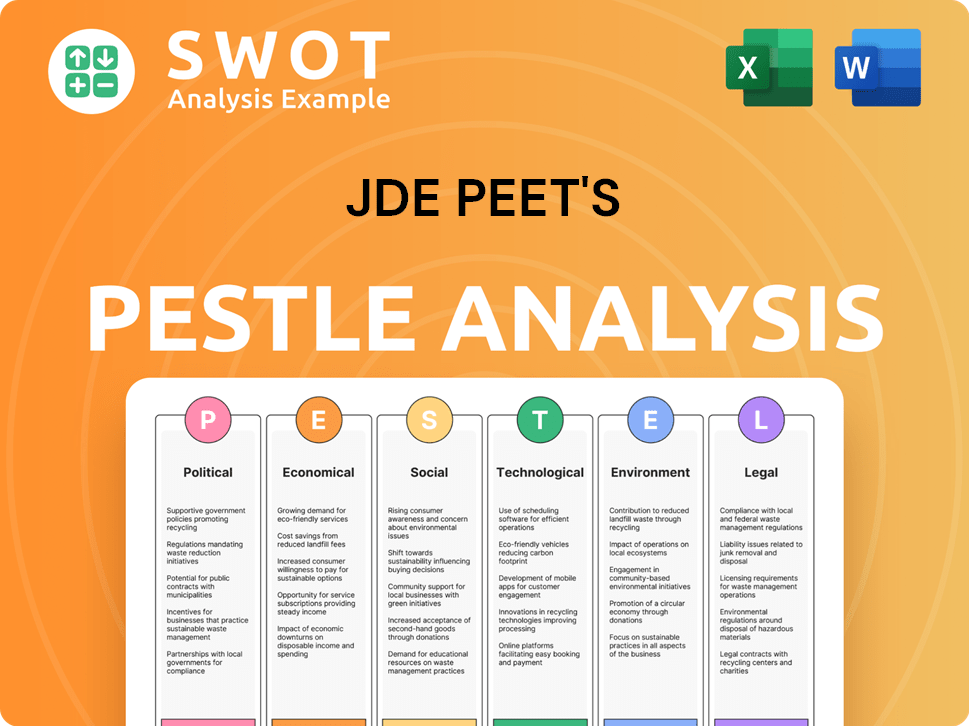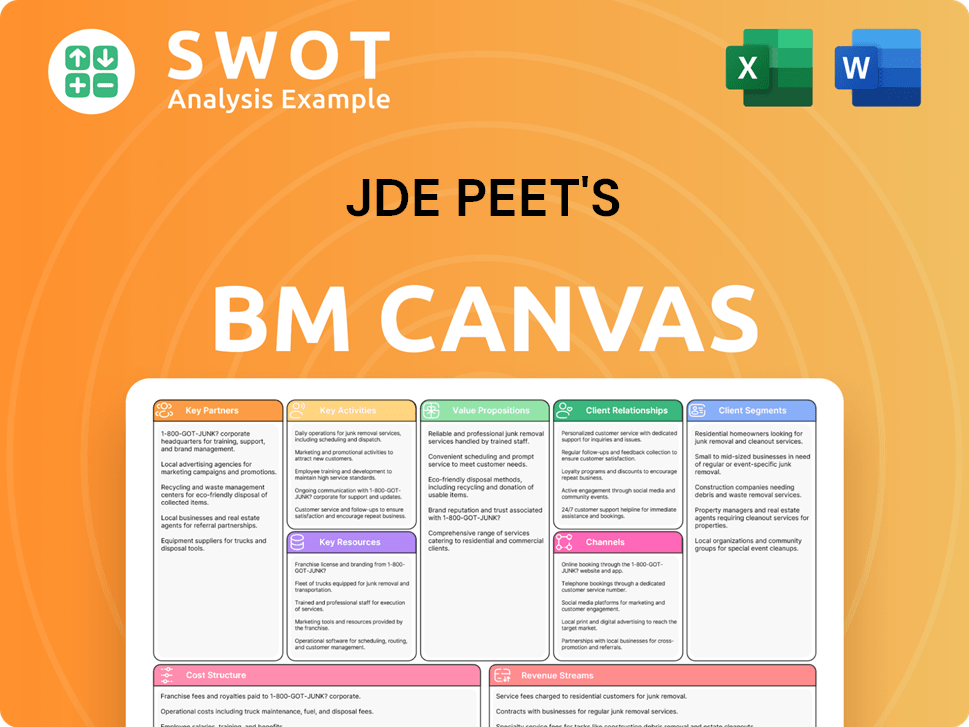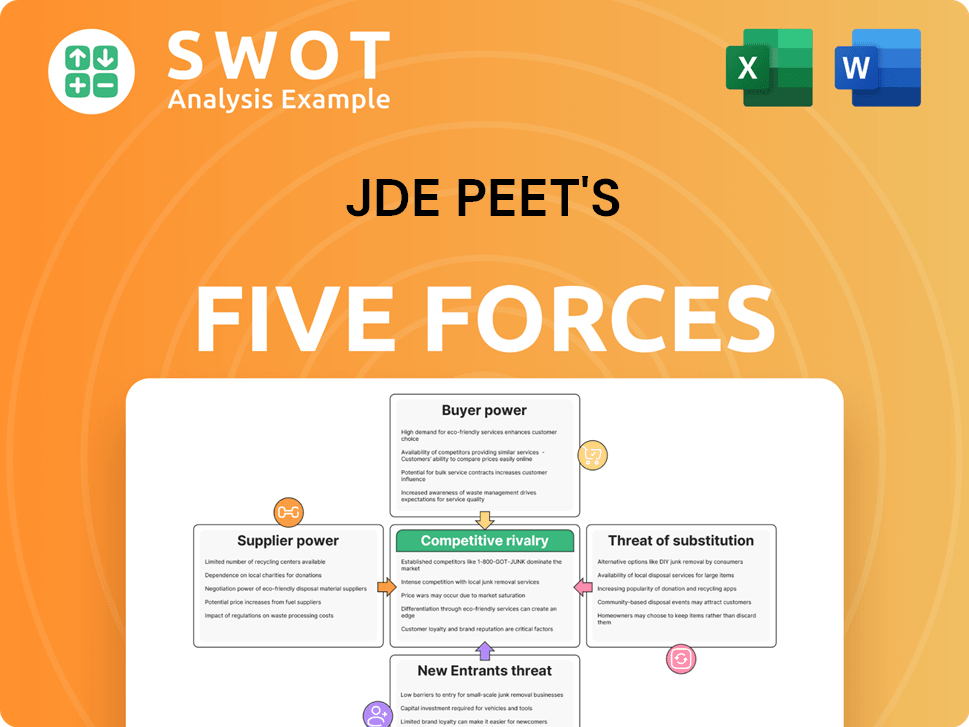JDE Peet's Bundle
How Does JDE Peet's Dominate the Global Coffee and Tea Market?
In the bustling world of consumer packaged goods, JDE Peet's stands out as a titan, but how does it maintain its leading position? The 2020 merger of Jacobs Douwe Egberts and Peet's Coffee created a powerhouse, instantly reshaping the coffee and tea landscape. This strategic move, along with its JDE Peet's SWOT Analysis, has allowed the company to leverage a vast portfolio of brands and a global reach.

This exploration will dissect JDE Peet's sales strategy and marketing strategy, revealing the core components of its success. We'll examine its multifaceted approach, from diverse distribution channels to innovative marketing campaigns, and how it navigates the competitive coffee market analysis. Understanding JDE Peet's business model and brand positioning is key to appreciating its enduring influence in the industry, especially when considering its expansion strategy in Asia and other key markets.
How Does JDE Peet's Reach Its Customers?
The sales strategy of JDE Peet's is multifaceted, utilizing a blend of channels to reach a broad consumer base globally. This approach ensures that its coffee and tea products are accessible through various avenues, both online and offline. The company's business model is designed to maximize market penetration and cater to diverse consumer preferences and purchasing behaviors.
JDE Peet's marketing strategy focuses on leveraging both traditional and digital channels. This includes a strong presence in physical retail locations, such as supermarkets and convenience stores, which remain crucial for mass-market brand distribution. Simultaneously, the company has invested significantly in e-commerce and direct-to-consumer sales, reflecting the increasing importance of digital platforms. These strategies support JDE Peet's goal of maintaining and expanding its market share in the competitive coffee market.
The company's sales channels are designed to cater to different consumer segments and purchasing behaviors. This includes a strong presence in traditional retail outlets, a growing e-commerce platform, and a robust out-of-home segment that serves offices, hotels, and restaurants. Strategic partnerships and exclusive distribution deals further enhance its market reach. For more insights, you can explore the Brief History of JDE Peet's.
Physical retail locations, including supermarkets, hypermarkets, and convenience stores, are a cornerstone of JDE Peet's distribution strategy. These channels are particularly important for mass-market brands. In the first half of 2024, the retail segment experienced a strong organic growth of 3.3%, demonstrating the continued relevance of these channels.
E-commerce platforms and company websites are utilized for direct-to-consumer sales. This channel has seen significant investment and growth, especially since the COVID-19 pandemic accelerated digital adoption. The company is expanding its e-commerce capabilities to align with industry trends.
This segment serves offices, hotels, restaurants, and cafés through direct sales teams and wholesale distributors. It is a crucial channel for professional coffee systems and bulk tea offerings. Organic growth in this segment increased by 5.4% in the first half of 2024.
JDE Peet's engages in strategic partnerships with key retailers and has exclusive distribution deals. These arrangements contribute to its market share and growth. The company ensures broad availability of its diverse brand portfolio, including brands like Jacobs and Peet's Coffee.
JDE Peet's utilizes a comprehensive mix of sales channels to ensure its products reach a diverse global customer base. The company's sales strategy includes both traditional retail and digital platforms. This multi-channel approach is essential for brand positioning and maintaining a strong presence in the consumer packaged goods market.
- Traditional Retail: Supermarkets, hypermarkets, and convenience stores.
- E-commerce: Direct-to-consumer sales via online platforms.
- Out-of-Home: Offices, hotels, restaurants, and cafés.
- Strategic Partnerships: Exclusive distribution deals with key retailers.
JDE Peet's SWOT Analysis
- Complete SWOT Breakdown
- Fully Customizable
- Editable in Excel & Word
- Professional Formatting
- Investor-Ready Format

What Marketing Tactics Does JDE Peet's Use?
The marketing tactics employed by JDE Peet's are multifaceted, designed to boost brand awareness and drive sales across its diverse portfolio. The company uses a blend of digital and traditional strategies to reach its target audience effectively. This approach is crucial in the competitive coffee market, where brand positioning is key.
Digital marketing is a significant focus, with content marketing playing a vital role. This includes storytelling around coffee origins and brewing methods, alongside targeted SEO strategies. Paid advertising on social media platforms like Facebook, Instagram, and YouTube is also essential. Email marketing is used to retain customers and promote new products.
Traditional media, such as TV, radio, and print advertisements, are still part of the marketing mix, especially for mass-market brands. Events and sponsorships also help build brand presence and engage consumers. The company's approach is increasingly data-driven, using customer segmentation and personalization for more relevant messaging. For more on their target audience, see Target Market of JDE Peet's.
JDE Peet's leverages digital channels for a wide reach. This includes content marketing, SEO, and paid advertising on platforms like Facebook and Instagram. Email marketing is also a key component, used for customer retention and new product launches.
Traditional media such as TV, radio, and print advertisements are still used to reach a broad audience. These campaigns are particularly effective for mass-market brands within the company's portfolio.
The company uses customer segmentation and personalization to deliver more relevant messaging and product recommendations. Advanced CRM systems and marketing automation platforms are used to manage customer interactions and campaign performance.
There is an increased emphasis on sustainability messaging and partnerships. This aligns with growing consumer demand for ethically sourced and environmentally friendly products. This is a key element of their brand awareness strategies.
JDE Peet's participates in events and sponsorships to enhance brand presence and engage directly with consumers. These activities help in building brand awareness.
The company operates in a competitive landscape, facing rivals like Starbucks. Understanding the competitive landscape analysis is crucial for effective marketing strategies.
The company's marketing strategy integrates digital and traditional methods, with a strong emphasis on data-driven decision-making and sustainability. This approach supports their sales strategy for coffee products and helps them compete effectively in the consumer packaged goods market. The company's expansion strategy in Asia is likely to incorporate these tactics.
- Digital Marketing: Content marketing, SEO, social media advertising, and email campaigns.
- Traditional Media: TV, radio, and print advertisements for broad reach.
- Data-Driven: Customer segmentation and personalization for relevant messaging.
- Sustainability: Emphasis on ethical sourcing and environmental responsibility.
- Events and Sponsorships: Enhancing brand presence and consumer engagement.
JDE Peet's PESTLE Analysis
- Covers All 6 PESTLE Categories
- No Research Needed – Save Hours of Work
- Built by Experts, Trusted by Consultants
- Instant Download, Ready to Use
- 100% Editable, Fully Customizable

How Is JDE Peet's Positioned in the Market?
JDE Peet's strategically positions its diverse portfolio of coffee and tea brands to cater to a broad spectrum of consumer preferences. This is achieved through a blend of heritage, quality, innovation, and a growing emphasis on sustainability. Their core message often centers around delivering enjoyable experiences through superior coffee and tea products. The company's visual identity and tone vary significantly across brands, reflecting the different market segments they target.
The company's brand positioning strategy is crucial for its success in the competitive coffee market analysis. For instance, Peet's Coffee is positioned as a leader in the premium coffee segment, appealing to consumers seeking high-quality, craft-roasted beans and a distinct coffee shop experience. Brands like Senseo and Tassimo, on the other hand, cater to the convenience-driven market with their single-serve coffee systems. The company's JDE Peet's sales strategy and JDE Peet's marketing strategy are closely aligned with these brand positions.
A key element of JDE Peet's brand positioning is its commitment to sustainability. By aiming to source 100% responsibly sourced coffee and tea by 2025, the company aligns with growing consumer demand for ethical and environmentally conscious products. This commitment helps build brand loyalty and attracts consumers willing to pay a premium for sustainable options. This approach is a critical component of their JDE Peet's business model.
Brands like Jacobs and Douwe Egberts leverage their long-standing heritage to build trust and appeal to consumers seeking familiar and comforting experiences. Peet's Coffee emphasizes its craft-roasting expertise and commitment to quality, attracting coffee enthusiasts. This focus on quality is a key element of their brand positioning JDE Peet's.
The company offers innovative products like single-serve coffee systems (Senseo, Tassimo) to cater to the convenience-driven market. They continuously introduce new flavors and formats to meet evolving consumer preferences. These innovations support their overall JDE Peet's sales strategy for coffee products.
JDE Peet's is committed to sourcing 100% responsibly sourced coffee and tea by 2025. This commitment resonates with consumers who prioritize ethical and environmentally friendly products. This is a core component of their JDE Peet's sustainability marketing efforts.
The company segments its target audience based on preferences, lifestyles, and price sensitivity. Peet's Coffee targets premium coffee drinkers, while other brands cater to mass-market consumers. Understanding JDE Peet's target audience demographics is crucial.
JDE Peet's maintains brand consistency across all channels, from packaging to digital campaigns, ensuring a cohesive brand experience. They actively monitor consumer sentiment and competitive threats, adapting their positioning to stay relevant in the dynamic global beverage market. For more insights, you can refer to the Growth Strategy of JDE Peet's.
Peet's Coffee targets the premium segment, while brands like Jacobs appeal to a broader, mass-market audience. This dual approach allows JDE Peet's to capture a larger market share. This strategy is a key part of their JDE Peet's competitive landscape analysis.
The company uses digital marketing to enhance brand awareness and engage with consumers. Social media campaigns and targeted advertising are key components of their strategy. This is part of their JDE Peet's digital marketing initiatives.
JDE Peet's uses multiple distribution channels, including retail, online, and food service. This multi-channel approach ensures product availability and supports sales growth. Analyzing their JDE Peet's distribution channels analysis is crucial.
Pricing strategies vary by brand and product, reflecting the target market and positioning. Premium brands command higher prices, while mass-market products are competitively priced. Examining their JDE Peet's pricing strategy for coffee beans is important.
JDE Peet's competes with major players like Starbucks and Nestle. Understanding the competitive landscape is crucial for effective brand positioning and market share growth. This includes how JDE Peet's competes with Starbucks.
The company continues to explore expansion opportunities in various regions, including Asia. Adapting brand messaging and product offerings to local preferences is key to success. This relates to their JDE Peet's expansion strategy in Asia.
JDE Peet's Business Model Canvas
- Complete 9-Block Business Model Canvas
- Effortlessly Communicate Your Business Strategy
- Investor-Ready BMC Format
- 100% Editable and Customizable
- Clear and Structured Layout

What Are JDE Peet's’s Most Notable Campaigns?
JDE Peet's has historically employed diverse sales and marketing campaigns to bolster its brand presence and drive growth within the competitive coffee market. These campaigns are tailored to specific brands within its portfolio, like Jacobs and Peet's Coffee, each targeting different consumer segments and leveraging unique strategies to achieve their objectives. The company's approach underscores a commitment to understanding consumer preferences and adapting its marketing efforts to resonate effectively with its target demographics.
The company's marketing strategies reflect a nuanced understanding of the coffee market analysis, with campaigns designed to enhance brand awareness and foster consumer loyalty. These efforts are often measured by key performance indicators (KPIs) such as engagement rates, website traffic, and sales lift. JDE Peet's also focuses on sustainability marketing efforts to appeal to environmentally conscious consumers, further solidifying its brand image and market position within the consumer packaged goods sector.
While specific details of current campaigns are proprietary, the company's past strategies offer insights into its approach. For example, campaigns for Jacobs have centered on emotional storytelling, while Peet's Coffee has emphasized its artisanal roasting process. These differentiated approaches enable JDE Peet's to effectively compete with rivals like Starbucks and maintain a strong presence in the global coffee market.
Jacobs campaigns often center on emotional storytelling, using TV and digital ads to build brand recognition. These campaigns aim to increase brand awareness and drive repeat purchases. The focus is on reinforcing Jacobs as a household staple, appealing to a broad consumer base.
Peet's Coffee campaigns highlight the artisanal roasting process and the origin of its beans. Digital channels, including social media and influencer collaborations, are heavily used to build credibility. These campaigns target coffee enthusiasts and aim to drive traffic to shops and e-commerce platforms.
JDE Peet's engages in sustainability-focused campaigns to promote responsible sourcing and partnerships. These campaigns utilize digital content, PR, and collaborations with non-profit organizations. They resonate with environmentally conscious consumers and boost brand perception.
Digital marketing is a key element, with social media marketing tactics and online advertising playing crucial roles. These initiatives aim to increase engagement and drive sales. Data-driven strategies are used to optimize campaigns and enhance customer relationship management.
The success of JDE Peet's sales strategy and marketing strategy is measured through various KPIs. This includes brand awareness, website traffic, and sales lift, particularly in the premium segment. The company uses data to analyze the impact of its campaigns.
- Engagement Rates: Monitoring social media interactions and website visits.
- Sales Lift: Assessing the increase in sales following campaign launches.
- Market Share: Tracking changes in market share, especially in key regions.
- Brand Perception: Measuring consumer sentiment and brand loyalty.
JDE Peet's Porter's Five Forces Analysis
- Covers All 5 Competitive Forces in Detail
- Structured for Consultants, Students, and Founders
- 100% Editable in Microsoft Word & Excel
- Instant Digital Download – Use Immediately
- Compatible with Mac & PC – Fully Unlocked

Related Blogs
- What are Mission Vision & Core Values of JDE Peet's Company?
- What is Competitive Landscape of JDE Peet's Company?
- What is Growth Strategy and Future Prospects of JDE Peet's Company?
- How Does JDE Peet's Company Work?
- What is Brief History of JDE Peet's Company?
- Who Owns JDE Peet's Company?
- What is Customer Demographics and Target Market of JDE Peet's Company?
Disclaimer
All information, articles, and product details provided on this website are for general informational and educational purposes only. We do not claim any ownership over, nor do we intend to infringe upon, any trademarks, copyrights, logos, brand names, or other intellectual property mentioned or depicted on this site. Such intellectual property remains the property of its respective owners, and any references here are made solely for identification or informational purposes, without implying any affiliation, endorsement, or partnership.
We make no representations or warranties, express or implied, regarding the accuracy, completeness, or suitability of any content or products presented. Nothing on this website should be construed as legal, tax, investment, financial, medical, or other professional advice. In addition, no part of this site—including articles or product references—constitutes a solicitation, recommendation, endorsement, advertisement, or offer to buy or sell any securities, franchises, or other financial instruments, particularly in jurisdictions where such activity would be unlawful.
All content is of a general nature and may not address the specific circumstances of any individual or entity. It is not a substitute for professional advice or services. Any actions you take based on the information provided here are strictly at your own risk. You accept full responsibility for any decisions or outcomes arising from your use of this website and agree to release us from any liability in connection with your use of, or reliance upon, the content or products found herein.